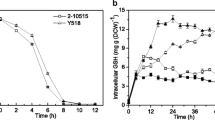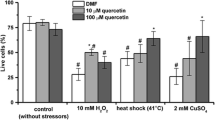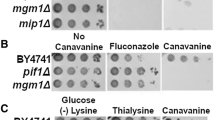Abstract
Growth of Saccharomyces cerevisiae ure2Δ mutant strain was investigated in the presence of diverse oxidant compounds. The inability of the strain to grow on a medium supplemented with H2O2 was confirmed and a relationship between diminishing levels of glutathione (GSH) and peroxide sensitivity was established. Data for the lack of significant effect of URE2 disruption on the cellular growth in the presence of paraquat and menadione were obtained. The possible role of Ure2p in acquiring sensitivity to oxidative stress by means of its regulatory role in the GATA signal transduction pathway was discussed. It was suggested that the susceptibility of ure2Δ mutant to the exogenous hydrogen peroxide can result from increased GSH degradation due to the deregulated localization of the γ-glutamyl transpeptidase activating factors Gln3/Gat1. The important role of Ure2p in in vivo glutathione-mediated reactive oxygen species (ROS) scavenging was shown by measuring the activity of antioxidant enzymes glutathione peroxidase, superoxide dismutase (SOD) and catalase in an URE2 disrupted strain. A time-dependent increase in SOD and catalase activity was observed. More importantly, it was shown that the ure2 mutation could cause significant disturbance in cellular oxidant balance and increased ROS level.






Similar content being viewed by others
References
Aebi H (1981) Methods for determination of enzyme activity. Catalase. In: Bergmeyer HU, Gawehn K (eds) Methods of enzymatic analysis, vol 2. Verlag Chemie Int., Deerfield Beach, FL, pp 673–684
Armstrong JS, Steinauer KK, Hornung B, Irish JM, Lecane P, Birrell GW, Peehl DM, Knox SJ (2002) Role of glutathione depletion and reactive oxygen species generation in apoptotic signaling in a human B lymphoma cell line. Cell Death Differ 9:252–263
Bai M, Zhou JM, Perrett S (2004) The yeast prion protein Ure2 shows glutathione peroxidase activity in both native and fibrillar forms. J Biol Chem 279:50025–50030
Basu U, Southron JL, Stephens JL, Taylor GJ (2004) Reverse genetic analysis of the glutathione metabolic pathway suggests a novel role of PHGPX and URE2 genes in aluminum resistance in Saccharomyces cerevisiae. Mol Genet Genomics 271:627–637
Beauchamp C, Fridovich I (1971) Superoxide dismutase: improved assays and an assay applicable to acrylamide gels. Anal Biochem 44:276–287
Bolton JL, Trush MA, Penning TM, Dryhurst G, Monks TJ (2000) Role of quinones in toxicology. Chem Res Toxicol 13:135–160
Bousset L, Belrhali H, Janin J, Melki R, Morera S (2001) Structure of the globular region of the prion protein Ure2 from the yeast Saccharomyces cerevisiae. Structure 9:39–46
Choi JH, Lou W, Vancura A (1998) A novel membrane-bound glutathione S-transferase functions in the stationary phase of the yeast Saccharomyces cerevisiae. J Biol Chem 273:29915–29922
Collinson EJ, Grant CM (2003) Role of yeast glutaredoxines as glutathione S-transferases. J Biol Chem 278:22492–22497
Cooper TG (2002) Transmitting the signal of excess nitrogen in Saccharomyces cerevisiae from the Tor proteins to the GATA factors: connecting the dots. FEMS Microbiol Rev 26:223–238
Coschigano PW, Magasanik B (1991) The URE2 gene product of Saccharomyces cerevisiae plays an important role in the cellular response to the nitrogen source and has homology to glutathione S-transferases. Mol Cell Biol 11:822–832
Delaunay A, Pflieger D, Barrault MB, Vinh J, Toledano MB (2002) A thiol peroxidase is an H2O2 receptor and redox-transducer in gene activation. Cell 111:471–481
Fernandez-Canon JM, Penalva MA (1998) Characterization of a fungal maleylacetoacetate isomerase gene and identification of its human homologue. J Biol Chem 273:329–337
Frova C (2006) Glutathione transferases in the genomics era: New insights and perspectives. Biomol Eng 23:149–169
Funk M, Niedenthal R, Mumberg D, Brinkmann K, Ronicke V, Henkel T (2002) Vector systems for heterologous expression of proteins in Saccharomyces cerevisiae. Methods Enzymol 350:248–257
Georis I, Feller A, Tate JJ, Cooper TG, Dubois E (2009) Nitrogen catabolite repression-sensitive transcription as a readout of Tor pathway regulation: the genetic background, reporter gene and GATA factor assayed determine the outcomes. Genetics 181:861–874
Grant CM, Perrone G, Dawes IW (1998) Glutathione and catalase provide overlapping defenses for protection against hydrogen peroxide in the yeast Saccharomyces cerevisiae. Biochem Biophys Res Commun 253:893–898
Gurgul E, Lortz S, Tiedge M, Jorns A, Lenzen S (2004) Mitochondrial catalase overexpression protects insulin-producing cells against toxicity of reactive oxygen species and proinflammatory cytokines. Diabetes 53:2271–2280
Inoue Y, Matsuda T, Sugiyama K, Izawa S, Kimura A (1999) Genetic analysis of glutathione peroxidase in oxidative stress response of Saccharomyces cerevisiae. J Biol Chem 274:27002–27009
Izawa S, Inoue Y, Kimura A (1996) Importance of catalase in the adaptive response to hydrogen peroxide: analysis of acatalasaemic Saccharomyces cerevisiae. Biochem J 320:61–67
Jamieson DJ (1998) Oxidative stress response of the yeast Saccharomyces cerevisiae. Yeast 14:1511–1527
Jiang H, English AM (2006) Phenotypic analysis of the ccp1Delta and ccp1Delta-ccp1W191F mutant strains of Saccharomyces cerevisiae indicates that cytochrome c peroxidase functions in oxidative-stress signaling. J Inorg Biochem 100:1996–2008
Kho CW, Phil YL, Kwang-Hee B, Sunghyun K, Sayeon C, Do HL, Choong-Hyun S, Gwan-Su Y, Byoung CP, Sung GP (2008) Gpx3-dependent responses against oxidative stress in Saccharomyces cerevisiae. J Microbiol Biotechnol 18:270–282
Lian HY, Jiang Y, Zhang H, Jones G, Perrett S (2006) The yeast prion protein Ure2: structure, function and folding. Biochem Biophys Acta 1764:535–545
Lowry OH, Rosebrough NJ, Farr AL, Randall RJ (1951) Protein measurement with the folin phenol reagent. J Biol Chem 193:265–275
Madeo F, Frohlich E, Ligr M, Grey M, Sigrist SJ, Wolf DH, Frohlich KU (1999) Oxygen stress: a regulator of apoptosis in yeast. J Cell Biol 145:757–767
Misra HP, Fridovich I (1977) Superoxide dismutase and peroxidase: a positive activity stain applicable to polyacrylamide gel electropherograms. Arch Biochem Biophys 183:511–515
Nedeva TS, Petrova VY, T Hristozova, Kujumdzieva A (2002) A modified procedure for isolation of yeast mitochondrial DNA. Z Naturforsch 57c:960–961
Nedeva TS, Petrova VY, Zamfirova DR, Stephanova EV, Kujumdzieva AV (2004) Cu/Zn superoxide dismutase in yeast mitochondria—a general phenomenon. FEMS Microbiol Lett 230:19–25
Petrova V, Drescher D, Kujumdzieva A, Schmitt M (2004) Dual targeting of yeast catalase A to peroxisomes and mitochondria. Biochem J 380:393–400
Rai R, Cooper TG (2005) In vivo specificity of Ure2 protection from heavy metal ion and oxidative cellular damage in Saccharomyces cerevisiae. Yeast 22:343–358
Rai R, Tate JJ, Cooper TG (2003) Ure2, a prion precursor with homology to glutathione S-transferase, protects Saccharomyces cerevisiae cells from heavy metal ion and oxidant toxicity. J Biol Chem 278:12826–12833
Reiter J, Herker E, Madeo F, Schmitt MJ (2005) Viral killer toxins induce caspase-mediated apoptosis in yeast. J Cell Biol 168:353–358
Springael JY, Penninckx MJ (2003) Nitrogen-source regulation of yeast gamma-glutamyl transpeptidase synthesis involves the regulatory network including the GATA zinc-finger factors Gln3, Nil1/Gat1 and Gzf3. Biochem J 371:589–595
Stephen DWS, Jamieson DJ (1996) Glutathione is an important antioxidant molecule in the yeast Saccharomyces cerevisiae. FEMS Microbiol Lett 141:207–212
Terao Y, Nakamori S, Tagaki H (2003) Gene dosage effect of L-proline biosynthesis enzymes on L-proline accumulation and freeze tolerance in Saccharomyces cerevisiae. Appl Environ Microbiol 69:6527–6532
Umland TC, Taylor KL, Rhee S, Wickner RB, Davies DR (2001) The crystal structure of the nitrogen regulation fragment of the yeast prion protein Ure2p. Proc Natl Acad Sci USA 98:1459–1464
Veal EA, Toone WM, Jones N, Morgan BA (2002) Distinct roles for glutathione S-transferases in the oxidative stress response in Schizosaccharomyces pombe. J Biol Chem 277:35523–35531
Vuilleumier S, Pagni M (2002) The elusive roles of bacterial glutathione S-transferases: new lessons from genomes. Appl Microbiol Biotechnol 58:138–146
Wickner R (1994) [URE3] as an altered URE2 protein: evidence for a prion analog in Saccharomyces cerevisiae. Science 264:566–569
Zhang Y (2000) Role of glutathione in the accumulation of anticarcinogenic isothiocyanates and their glutathione conjugates by murine hepatoma cells. Carcinogenesis 21:1175–1182
Zhang ZR, Perrett S (2009) Novel glutaredoxin activity of the yeast prion protein Ure2 reveals a native-like dimmer within fibrils. J Biol Chem 284:14058–14067
Zhao TJ, Singhal SS, Piper JT, Cheng J, Pandya U, Clark-Wronski J, Awasthi S, Awasthi YC (1999) The role of human glutathione S-transferases hGSTA1-1 and hGSTA2-2 in protection against oxidative stress. Arch Biochem Biophys 367:216–224
Acknowledgments
We thank Ivan Tarassov for providing the p413 vector and to Ales Vancura for pET23b-URE2 and pET23b-URE2(ΔN) plasmids. This work was supported by a CNRS ATIP grant to S.V., by a grant from National Science Fund of Bulgarian Ministry of Education and Science (Project Б-BУ-201/06) to A.K., and by a visiting scientist grant of the European Doctoral College of Strasbourg to A.K. T.T. was the recipient of an Agence Universitaire de la Francophonie PhD grant, and was a member of the European Doctoral College of Strasbourg.
Author information
Authors and Affiliations
Corresponding author
Additional information
Communicated by Axel Brakhage.
Rights and permissions
About this article
Cite this article
Todorova, T.T., Petrova, V.Y., Vuilleumier, S. et al. Response to different oxidants of Saccharomyces cerevisiae ure2Δ mutant. Arch Microbiol 191, 837–845 (2009). https://doi.org/10.1007/s00203-009-0512-9
Received:
Revised:
Accepted:
Published:
Issue Date:
DOI: https://doi.org/10.1007/s00203-009-0512-9




